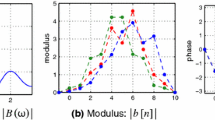Summary
By use of a Fourier-coefficient shift and subsequentz-transform, we employ the familiar process of replacing image trigonometric polynomials by polynomials in one or more variables. Among these polynomials we consider a «standard» type and define a «conjugation» on them. This conjugation has some of the same important properties as does the conjugation of complex numbers and this enables us to prove that the single concept which unifies the enumeration of phase ambiguities from amplitude data for images in any number of dimensions is «prime flipping». This reduces to «zero flipping» in the one-dimensional case. The presence of self-conjugate primes in the polynomial of an image does not lead to phase ambiguities, just as the presence of real zeros in the one-dimensional case does not produce such ambiguities. We show that all phase solution images which produce the same intensity must have the same integral band width.
Riassunto
Usando uno spostamento del coefficiente di Fourier e la conseguente trasformazionez, si usa il familiare processo di sostituire i polinomi trigonometrici dell'immagine con polinomi ad una o piú variabili. Tra questi polinomi si considera, un tipo «standard» e si definisce in questi una «coniugazione». Questa coniugazione ha alcune importanti proprietà in comune con la coniugazione dei numeri complessi, e ciò ci permette di provare che il concetto singolo che unifica l'enumerazione delle ambiguità di fase da dati di ampiezza per immagini in qualsiasi numero di dimensioni è «prime flipping». Ciò riduce allo «zero flipping» nel caso unidimensionale. La presenza di «prime» autoconiugati nel polinomio di un'immagine non porta ad ambiguità di fase, proprio come la presenza di zero reali nel caso monodimensionale non produce tali ambiguità. Si mostra che tutte le immagini di soluzione di fase che producono la stessa intensità devono avero la stessa ampiezza di banda integrale.
Резюме
Используя сдвиг Фурье-коэффициента и последующееz-преобразование, мы применяем обычный метод замены мнимых тригономертрических полиномов полиномами с одной или более переменными. Среди этих полиномов мы рассматриваем «стандартный» тип и определяем «сопряжение». Это сопряжение обладает такими же важными свойствами, как и сопряжение комплексных чисел. Это сопряжение позволяет нам доказать, что единственная концепция, которая объединяет перечень фазовых неоднозначностей из амплитудных данных для отображения при любом числе переменных, является «символ переворачивания». Это сводится к «нулевому переворачиванию» в одномерном случае. Наличие самосопряженных символов в полиноме отображения не приводит к фазовым неоднозначностям, так же как наличие вещественных нулей в одномерном случае не приводит к таким неоднозначностям. Мы показываем, что все отображения фазовых решений, которые производят такую интенсивность, должны иметь такую же интегральную ширину полосы.
Similar content being viewed by others
References
E. M. Hofstetter:IEEE Trans. Inf. Theory,10, 119 (1964).
Yu. M. Bruck andL. G. Sodin:Opt. Commun.,30, 304 (1979).
M. H. Hayes:IEEE Trans. Acoust. Speech Signal Process.,30, 140 (1982).
A. Walther:Opt. Acta,10, 41 (1963).
E. L. O'Neill andA. Walther:Opt. Acta,10, 33 (1963).
W. Lawton:J. Opt. Soc. Am.,71, 1519 (1981).
E. C. Titchmarsch:The Theory of Functions (London, 1939), p. 246.
B. J. Brames andJ. C. Dainty:J. Opt. Soc. Am.,71, 1542 (1981).
G. Birkhoff andS. MacLane:A Survey of Modern Algebra (New York, N. Y., 1953), p. 75. Thus the integral domainC[v1,v2,...,vk,] in any number of variables is a unique factorization domain, where the prime factors in a polynomial factorization are unique to within a constant complex multiplier. Any two polynomialsF andG which differ only in this way are called «associates».
M. H. Hayes andJ. H. McClellan:Proc. IEEE,70, 197 (1982).
J. R. Fienup:Opt. Lett.,3, 27 (1978).
Author information
Authors and Affiliations
Additional information
To speed up publication, the author of this paper has agreed to not receive the proofs for correction.
This research has been partially supported by the La Jolla Institute and by the National Science and Engineering Research Council of Canada.
Traduzione a cura della Redazione.
Переведено редакцией.
Rights and permissions
About this article
Cite this article
Montgomery, W.D. Phase ambiguities in higher dimensions. Nuovo Cimento B 75, 195–206 (1983). https://doi.org/10.1007/BF02831173
Received:
Published:
Issue Date:
DOI: https://doi.org/10.1007/BF02831173




